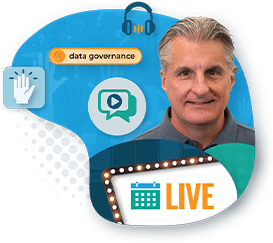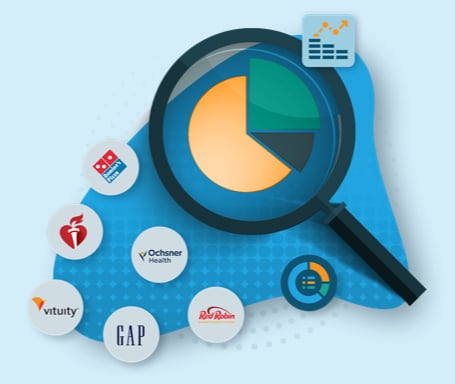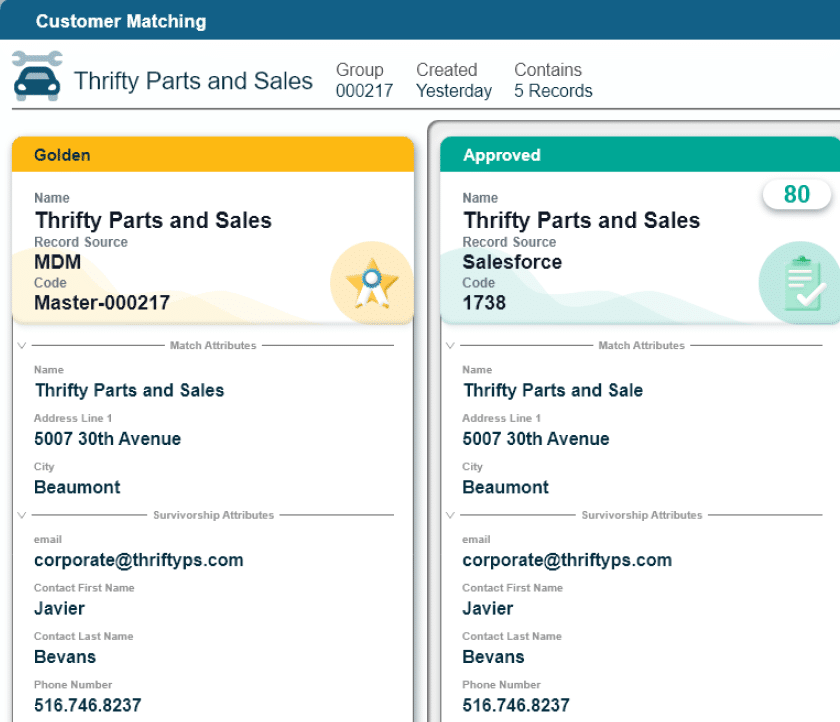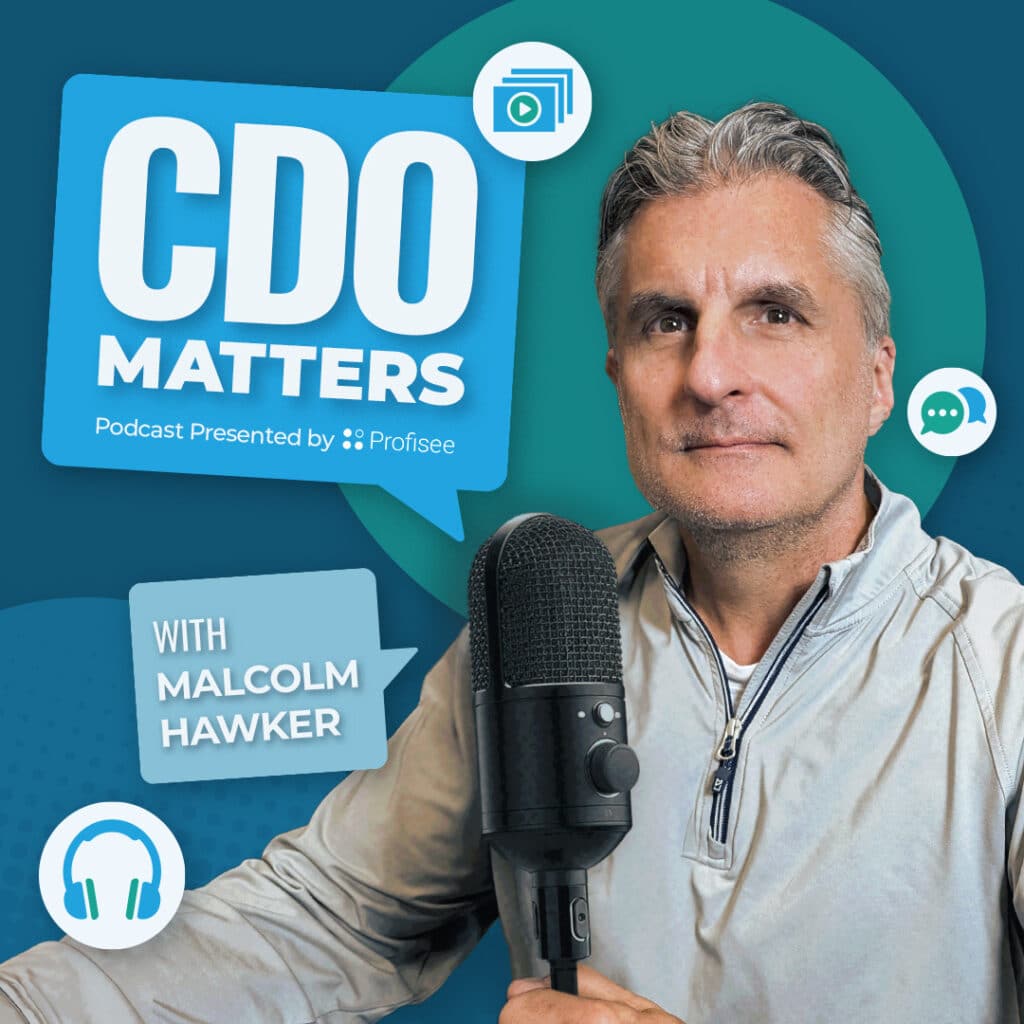Episode Overview:
In this episode of CDO Matters, Malcolm interviews the President and COO of BlueConic, Cory Munchbach. Cory is a fellow recovering analyst and runs one of the top Customer Data Platform, or CDP, solutions available in the market today. In her role, Cory is at the forefront of some of the biggest customer experience and digital transformation initiatives of many of the best-known brands on the planet.
During their discussion, the two focus on the role of women in technology and how we can improve on the many gender imbalances that continue to persist both in their companies, and society at large.
They also discuss the role of CDPs in the digital transformation landscape, and how those solutions differ from other customer-data management solutions – such as MDM or analytics platforms. If you are one of the 25% of CDOs tasked with executing your organization’s digital transformation initiative, this episode of CDO Matters will help bring you to a higher-level understanding of how CDPs ‘fit’ into a broader MarTech and IT technology stack, and the value they bring to the organization.
The conversation closes with a dialog around the possibility of a coming recession, and what CDOs and other senior leaders can do to best prepare for some form of economic slowdown. Cory shares her experience in working with major consumer-facing brands over the last recession, and how many ‘doubled down’ digital transformation investments as a means to improve customer relationships and drive competitive advantage.
Key Moments
- 01:56-4:43 The current market of Customer Data Platforms (CDPs)
- 04:56-6:30 Activating customer data throughout the organization with CDPs
- 6:35-7:35 How do Chief Data Officers (CDOs) benefit from CDPs?
- 8:00-11:31 How CDPs can co-exist with master data management (MDM)
- 11:42-14:22 Thoughts on the underrepresentation of women in leadership positions in tech
- 15:04-18:05 Pay transparency as a catalyst for equality in the workplace
- 18:15-18:58 Being the only woman on the leadership team
- 19:06-21:58: The impact of tech companies on expanding access to benefits
- 22:10-24:33: How CDOs can respond to economic uncertainty
- 24:35-26:22: Building a data strategy around a clear business objective
- 26:24-31:43: How GDPR, CDPA and other regulations will continue past 2022
Key Takeaways:
The Coexistence of CDPs and MDM (9:15-9:37)
“I would have conversations…with IT leaders…about this false perception that it was either CDP or MDM. My answer always was both.” – Malcolm Hawker
The Underrepresentation of Women in Technology (12:06-14:04)
“…this is much less of a tech problem and more of a social problem…we’ve always had an underrepresentation of women in technology, so there haven’t been enough people to go to battle for the kind of things that will make more women come.” – Cory Munchbach
Pay Transparency in the Workplace (15:38-17:08)
“If you have a certain role…then everyone in that role should be within that pay band…over time, your value for the organization grows and we don’t make a lot of adjustments for that internal expertise…” – Cory Munchbach
Responding to Economic Uncertainty (23:19-25:24)
“I am a big believer that you should plan for the worst and hope for the best…this should be transformational because it changes how you work…the thing that you need to have is the relationship with your customer.” – Cory Munchbach
About the Guest
Cory is the current President and COO of BlueConic. She previously worked as an analyst for Forrester supporting marketing technology and the former author of the Forrester ‘Wave.’ While being an early-stage startup investor and advisor, Cory also serves as a member of Chief – a private network designed for the most powerful women in executive leadership.
Episode Links & Resources:
Hello, everybody. This is Malcolm Hawker, and I’m back with another episode of CDO Matters.
I’m excited today to be joined by Corey Munchbach, who is the president and COO of Bluconic Software. Corey, can you take a couple minutes to introduce yourself?
Yeah. I certainly can. Thanks so much for having me. As you said, I am president and COO at Bluconic. We’re a customer data platform and, have been working in this space with a range of customers, all over the world, some brands that probably many folks know, VF Corp, parent company for The North Face and Vans, Molson Coors, Heineken, Colgate, Michelin, a whole bunch of others that we’re very lucky to work with across the world. And our sort of primary function in doing that and part of why I joined the company as a former recovering analyst myself, but on the Forrester side, was really this sort of intersection of the way that we see, you know, marketing and growth strategies changing at companies largely driven by the relationship with the customer and and the data behind that, and really helping to sort of figure out what does that look like? How do you have a customer data enabled strategy?
How do you bring technology to bear in solving problems that are incredibly complicated, that there isn’t really a one size fits all.
And so that’s what I’ve been doing for the last almost eight years with BlueConnick, what our CDP does. And as I said, I was an analyst at Forrester before this covering the MarTech space. I wrote the first, wave on the marketing cloud. So this has sort of been the air I’ve been living and breathing for the last decade or so, even though it’s kind of crazy for me to to think about it that way.
Yeah. Time flies by, especially last couple especially the last couple of years.
So, I’m a CDO, and, I’ve never heard of a customer data platform before. Maybe I maybe I have, but I thought I already had that, with Adobe or some other solution, or maybe I thought I had that through Sales Force. What’s different with your software, and why would I be interested in using it?
Yeah. Great question. So one of the things that is fascinating that we could spend a whole lot of time talking about, but we won’t, is how interesting the CDP space and sort of the trajectory of the category, has been, as as I said, former analyst, it’s really behaved in ways that we haven’t seen out of a lot of tech categories before in the sense that most typically, you see a handful of vendors, let’s call it eight, ten, maybe twelve, that are sort of the leaders. They make it into the MQ or the wave or what have you. CDP has, depending on who you talk to, like, well over a hundred vendors that they claim to be CDPs.
What’s fascinating for me is that when you look at, for example, who we’re in competitive situations with, right, actual deal cycles, it really is only that eight to ten ish that you’d sort of see. But from sort of high above, if you are a CDO, you’re looking at the space, it’s super noisy. It’s seemingly enormous.
You have kind of preexisting vendors like Salesforce and Adobe and some others that have ostensibly added a CDP to their kind of broader tool belt, where we’ve always focused and, continue to sort of be, fixated on is largely around sort of these marketers and growth oriented users. So sort of nontechnical, people, generally speaking, although I think everyone is technical in some respects now.
And giving them a technology that that if we use the example of Salesforce and Adobe, right, those are Frankenstacks in and of themselves now, never mind within your own organization.
And they’re built on different architectures. They’ve got a lot going on. Bluconic is a single architecture, single platform designed to be agnostic within whatever tech stack ecosystem that you have. And the whole purpose and the reason that we exist is that you probably do have a data lake, MDM, sort of back office, like, deep, deep technical solutions for your data, but very little access to that data from the marketers, from the customer experience professionals who could incredibly transform that into the kinds of downstream experiences and understanding of the customer journey. So solving for that piece in between, I sometimes think about it as a translation between that back office system, and the downstream marketing systems and being that sort of translation layer between core components of your tech stack.
So you’re not trying to replace a data warehouse. You’re not trying to replace an MDM.
You’re just trying to give marketers more freedom and arguably more control over some of that customer data?
Exactly. So we’ve talked a lot about sort of accessibility, as being a big component of this, utility of that data. Right? There’s a very practical kind of angle to what we’re doing.
And in part, it’s it’s also I use a, like, a lot of this analogy is sort of what tag management ended up being to web content management, where you don’t want a lot of people touching your website and all of that code, but tag management made you sort of get a sandbox, like a a consolidated access point that made it easier to make changes and and use the data. CDP is very similar actually for MBM and data warehouses where those are far more complex. They hold a lot more types of data, right, whether it’s tables, whatever your structure is. There’s so much going on there.
Whereas, we wanna say, hey. Look. You have all that awesome information. How do we make sure that that informs a website experience?
How do we make sure that that is landing when we send someone an email? How do we make sure that our loyalty program and how that interacts, you know, is is up to date and can sort of compile that information? So utility access, sort of that general activation concept.
If we’re not helping to activate the data, then honestly and we’re kind of saying we shouldn’t even have it. There’s no need for the data to be in Plicanic if you don’t have an express purpose for it, which is why a lot of our sort of model is around the use cases and what you plan to do with the data rather than that sort of data ingestion and figure it out later kind of approach.
Got it. Got it. Are you selling to CDOs?
A little bit. We’re certainly starting to see more and more, getting involved there. I mean, I think much like we’ve seen in other areas where the pendulum sort of for new technology sort of swings outside of IT or sort of that core, whatever, back kind of function, whatever you call it in your organization, as that technology progresses in its own maturity cycle, and becomes more strategic, then, you know, you start to get IT back involved. So, I think we’re very much in that phase of of the technology overall.
And I think, by the way, that’s a really important good thing to have that find that sweet spot. I don’t think it’s great when it swings too far over, and I also don’t think it’s viable for it to sort of swing too far to the business and stay there. I think it’s actually really positive when a technology finds a good way to find a happy medium, and oftentimes, CD CDOs are getting more involved than CTOs and sort of other technical functions, at least in the evaluation and making sure that it’s a good choice for the company overall.
Yeah. I mean, we certainly see saw that when I was at Gartner. I think Gartner recently published their, annual CDO survey, and their last year survey said that, upwards of twenty five percent of CDOs are, responsible for digital transformation initiatives within their organization, which is where you live and breathe. Right?
Absolutely. And that’s a key component of this as well. It’s like, where does this fit into what your broader organization is trying to do? What are the other choices that you’re making around your tech stack, your initiatives?
And then how do you sort of design an architecture around that. One of the things that I think is so positive about where technology is now is that there is just a lot more flexibility of of any solution if you’re using something from the last five or ten years, certainly as compared to before that. But that makes I think that the flip side of it is, one, it’s kind of new frontier, but also it does introduce a lot more decisions into the process because you do need to be more agile. You do need to be able to be more dynamic. And I think right now, I’m seeing a lot of digital transformation projects that are still kind of early enough in their journey that some of those decisions just remain open, and it sort of becomes a, alright. We’re just gonna have to make one or two choices and then kinda deal with later later because, otherwise, you’re just trying to orbit around too many different variables.
And I do think that’s also where TDOs with that kind of background can help prioritize and kind of create that road map, whereas the business is gonna be focused on likely more immediate needs and sort of pain points that this can solve. I think that’s a healthy balance to to sort of bring to the conversation as well.
Yeah. That balance makes total sense. I I would have conversations all the time with IT leaders, including CDOs that had this kind of this false perception that it was a or b. It was a CDP, a customer data platform, or it was MDM.
And my answer almost always was actually probably both. Right? Because your marketers have burning needs right now. You do have enterprise wide needs that are probably very, very real, but there are those campaigns that need to get executed.
Yeah. Absolutely. And I think, like, the we we joke basically on a t shirt around here of the answer is it depends. I mean, the the like, the like, that’s the sort of challenge right now. Right? Is it the by the benefit of choice is you have to make them. And and I think there’s a lot of, like partially, it’s not having experience making those kind of choices.
A lot of it, especially for our buyer that is less technical, there’s a certain risk aversion, right, that you we know you make a bad technology decision of this scale and scope, doesn’t work out, that may not be a job for you for much longer. And on the flip side, done well, it can be, you know, a career propellant. So these are high stakes decisions that people are making but are new to, especially with CDP. And so making sure that, you know, we’re certainly trying to guide around when we say it depends, you know, here’s some of the factors that it depends on.
We can give you examples. We can sort of say, here’s one choice and way that three different customers made the choice, but ultimately, that’s back on you. And, again, going back to that point where, you know, that that integration or sort of relationship between the business and the technical side can be so helpful when it’s done well is healthfully evaluating what those trade offs are because there will be some. I think what ends up happening is if one side makes all the choices and at the expense of the other, it just neutralizes any possibility of moving forward.
But we do find that certainly when there’s a more kind of cross functional collaborative approach to this, also from brands and different stakeholders, it is measurably more impactful and efficient, by the way. Right? Onboardings can take three to four months instead of three to four quarters when you have that alignment early on.
Good stuff. Let’s transition.
I we could you you know, we have talked about CDPs and MDMs and data management and and on and on for a long, long time. I would love given your success and given where you are in your career, I I would love to better understand your perspective around, women in technology.
Right? Why are there so few women in senior leadership positions within technology, and what do we need to do as a community to to to right the ship?
Yeah. You know, it’s funny, Malcolm. I think I would have answered this question, in a more circumspect way a couple of months ago, but, we’ve seen over the last just even couple of weeks just how much, even I and maybe we as a tech community have sort of underestimated how much this is actually not a tech problem and much more broadly a an a a social problem. And I I don’t mean to be flip or kind of stray us too far afield, but I really I’m taking sort of a new lens to this, which is that we saw it with, you know, women leaving the workforce in droves because of disproportionate responsibilities for childcare or family care.
You know, this is part of why it remains such an acute problem in tech is that we never solved it in the first place. We’ve always had underrepresentation from women in technology, so there haven’t been enough people to to battle for the kind of things that will make more women come. Right? It is a little bit of a if you build it, they will come model where if you build in good parental leave for both parents, by the way, if you build in more support for different types of people, again, not just for women, those inclusive environments beget more more types of people coming to work for them, and it’s just the reality of that if you haven’t lived it, you can’t represent that in the boardroom.
You can’t go to bat for it, on the leadership team. And so, you know, it’s it’s a little bit self defeating, I think, in that regard. And the just the deficit that tech started from on this, I think the reason for some amount of optimism is that whether it was COVID or some of the recent decisions made in the United States have just laid bare that trying to avoid this is not an option, that there needs to be a path forward, which has created space to have that conversation and to to start to actually make some of those changes that will make it more viable for women to participate fully in tech and make that a fulfilling, joyful career for them.
So I I think it it is a bigger one, and maybe we’ve done ourselves a disservice by sort of trying to solve tech when really we need to take a wider lens and then apply that back to tech versus the other way around, sort of the top down versus the bottom up approach.
So there’s a few interesting things that you touched on. And if if I’m a CDO or a CEO or if or if I’m just me and I’m I’m asking, okay. Well, what can I do within the confines of of my organization?
Understanding there there are societal things that are going on. And I guess in theory, if we all cumulatively change how we act individually, we will drive the societal change. Right? I I think that that would that would be something certainly aspirational.
You you touched on on paid family leave. Mhmm. Like, you as a president of a company, that’s something that you have influence over. What are some of the other things? What about this this just came in my mind. Pay transparency.
Mhmm. Right? I I I’m I’m interested on on that one. Right? If we all knew how much we were paid, do you think that that would that would have a negative effect or or maybe a positive effect from the perspective of of of getting, equality of pay?
Yeah. I mean, I think pay transparency is a big one, and different companies have different approaches to this. I think at the bare minimum, having pay ranges, pay bands for different roles because there is nuance. It’s I at bigger companies, you know, you can have a more standardized approach. At smaller companies, People are doing different experiences.
But if you have a certain role and it has a pay band, then everyone who’s in that role should be within that pay band. And it gives you some amount of flexibility to go up or down based on experience, but it is more or less hard and fast as to why, you know, someone’s getting paid what they’re getting paid.
An annual pay audit is crucial. This is something that we do. Right? Our people had a people reviews against benchmarks, but also internally, making sure that going into an annual pay cycle that we’re making adjustments where we’re making them or where we need to make them. I think the other part that is often true as well in tech is, you know, over time, your value to the organization grows, and we don’t make a lot of adjustments for sort of that internal expertise, and I think that is also something that can end up hurting people.
I mean, Massachusetts, where I live, passed a law a couple of years ago now where you cannot ask what someone is making, which I think is also That’s fascinating.
An enormous improvement, and I would encourage anyone who hires, whether it’s legal well, legal too or not, don’t ask. It’s about what they’re worth to your organization. What are their pay expectations?
And if you’re not willing to pay someone what they think they should make or what the role commands, it has nothing to do with whether or not I was underpaid at my last job. It has everything to do with whether you think I’m qualified to do it now. So it’s those kind of choices as well that you can that tend to bias against people who are underrepresented in tech.
That is a big one. I would say another big aspect of this is also figuring out, you know, whether you are supporting people who need flexible schedules with childcare, and not as an exception, just as a standard part of the of the practice, again, depending on how big your company is. I myself do not have children, that doesn’t mean that I don’t think that we need to figure out how to make sure that people can take care for whoever they have in their lives.
So I think there’s a lot of things like that where pay transparency is a piece, but it is, to be frank, more about asking also the people in your organization who would be impacted by these things, what they are looking for, and how to bring that in than it is necessarily top down. Again, this is where the dearth of voices of of people who’d be impacted by these things. Right? Having young, often white men crafting policies. I mean, I was just to give you an example, Malcolm, I was employee seventeen at BlueConnick. I was the first woman, only woman.
Our cofounders were not young men in their twenties, but they were men, and I was the only woman. And, even at employee seventeen, things take root before I got there that have an impact, and they weren’t malicious. They but you underestimate the importance of having these voices and being part of it, that I I appreciate more and more in hindsight of sort of seeing that.
But I made it very clear, right, parental leave was super important to me. Again, I don’t have children, did not plan to at the time, but I knew to recruit women and parents, that was something that was gonna need to happen. So it’s it’s about having those voices and elevating them, going looking for them that I think makes most of the impact here.
Got it. So are there any other things from, from a policy perspective or just an internal initiative perspective that you guys are focusing on at BlueConnick?
I mean, there’s a lot. In the light of the dog’s decision, there we’ve added the rider to all of our health insurance to make sure that people continue to have access to health care. Being based in Boston, you have we’ve had sort of come up and be here anytime you need to open door policy to make sure that, we can support that at least for the time being.
Very vocal on all of that. So that’s one area of just recently in the last two weeks that making sure that we’re abundantly open about that. Also, again, making sure that just our health insurance is the best insurance that we can possibly provide to employees.
That’s, again, an executive level decision. Don’t cut corners there because it is enormously impactful also for people who need nonstandard care or trans care, other aspects of their lives that if you’re just giving the bare minimum, will make it very, very difficult for them to get the kind of care that they need. So that has been a big initiative for us this year is we redid our entire health care benefits earlier this year, to make sure that it was it was much better than what we’ve been offering before. So that has been probably the biggest change that we’ve made.
And then we have all kinds of great if you can’t measure it, it doesn’t doesn’t count. So a lot of just metrics that we hold ourselves to on a range of topics, just making sure that we’re thinking about this every single day, having the conversations with the team, getting the feedback on what’s working, what’s not working.
But I think help particularly coming out of the COVID experience and now also in the last couple of weeks, you know, recognizing how important the health care, can be for employees. The other thing I would say too is that, you know, I was pretty vocal about, you know, a lot of these companies are sort of offering to basically privatize the kind of support that women need, and I don’t think that helps, actually. I think it’s a really great way to get a press release and say that you do these things. But for me, you know, if you’re working in tech, in all likelihood, you are one of the privileged few who probably has better access to healthcare no matter what, right, just in general in a better position and I believe very deeply that our role is to make sure that the company is a place, the organization is a place where you are filling your own cup, that you are supported, that you are safe, such that you then can go back out into your community and make the change for other people.
Right? I I genuinely see the privilege of tech is the opportunity to make sure that that privilege goes beyond those of us who are in that echelon, and that can’t come from companies, but it can come from companies to our employees to then go agitate or do whatever that looks like for them in their personal and community lives.
I think I’d like to see more of that than stipends for travel out of state, which will already help the people who probably need it the least right now.
Right. Okay.
Great stuff. Thank you for sharing all of that. Let’s let’s let’s pivot now again to a thing that I think that is on the mind of a lot of executives and a lot of chief data officers, and this is the potential of some looming recession. Yes. I think that it’s pretty much at least from a economist consensus perspective. I think the general consensus is that we may not fully be in one yet, but that we’re working our way certainly towards one and that towards the end of this year, most certainly, things are gonna get a little more dire. I’ve I’ve heard, you know, things, related to supply chain impacts haven’t even worked their way all through the system yet and that there could be looming, even food issues, you know, from a lack of fertilizer and and wheat and other things that have been caused by the war in Europe.
Where are you at on on on this kind of the recession perspective? And if you are a chief data officer or some senior data leader, what would your advice be to that person in terms of readiness and what they should be thinking about over the next few months?
Yeah. I mean, what I find fascinating about this is I’ve, you know, pinpointing a recession. I thank god that’s not my job because it would not be a thing that I would be, equipped to do.
You know, I I’m a big believer sort of plan for the worst and hope for the best in these kinds of things.
You know, what I do see in terms of sort of how a business should be approaching this is that this is an area where probably customer data, at least the ones I take on it, is everyone’s already behind on that. There’s probably three or four companies that we can all name that are ahead of the curve here. So to cut back now puts you at probably an insurmountable deficit when it comes to these topics later on down the road. And so if you had COVID sort of accelerating digital transformation, as we know, right, the McKinsey data accelerating at around twenty four months depending on your industry, and now you have a recession. If you’re gonna cut again, you it came too fast and you were behind, and if you were to cut now, I don’t see a lot of ways sort of past that.
And so from my perspective, when you think about digital transformation and these things that are inherently a race to get to position and have competitive advantage, to cut now, you should just sort of bank on that you’re you’re not gonna make it out.
You’re you’re never getting that time back and and potentially fatally. So how can you be efficient about it? One thing that, you know, that I have championed for a long time is measuring technology, not just in terms of sort of downstream metrics, but also operational efficiency. So are we genuinely using this tool to the most effective use within our organization?
As in, can we make teams more efficient? Can we cut back on process? Have we really done the work to make sure that our change management affected processes such that we didn’t just, you know, get a a new pair of scissors instead of, right, a a an actual, like, massive complex TAD system? Right?
Like, this is this should be transformational because it changes how you work, not just because you bought it in the first place, or that you made the investment. So as we approach a recession or something that looks like a recession, the thing that you need to have at the other side of it is the relationship with your customer. You need to have your competitive advantage against the the competition, and those two things are inextricably linked. So not just at very least continuing the investment that you’ve made in this, but potentially increasing the investment in it such that you emerge from this in eighteen months or whatever it ends up being in a much stronger position, which all sort of historical precedent would indicate that you would, you know, that’s the CDO needs to be making the case for that because otherwise, again, eighteen months from now is gonna be a very different conversation than what you could be having, and there’s a lot of good reason to think that that’s true from historical, but also just even what we’re seeing today and what we know of the world.
So my advice is doubling down at the very minimum, and and making the case if you’re the CEO for this continued investment in data and that infrastructure to make the team more efficient and build that customer relationship to come out stronger on the other side.
With the caveat that you’d mentioned early on, meaning, do you have a well defined business outcome? Do you have a well defined business case that you’re supporting here? And for a lot of CDOs, at least a good quarter of you, if not a half of you, that is digital transformation. That is the customer experience. That is customer retention.
Right? And you also mentioned, precedent.
Yeah.
We don’t actually have to look that far back to find the precedent.
We only have to look back a couple of years because we did. A lot of people forget it because things were were flying so high, through through a lot of, twenty twenty one, economically. But in the spring of twenty twenty, we had a recession. It was very, very short.
Mhmm.
But there was still a recession recession there. And and what I saw, and I know you saw as well, was some companies running towards customer experience and customer retention and better data management and customer data platforms and MDM. Some companies ran towards it, and those that did are now starting to reap the the benefits of it. There’s a lot of sound bites out there. One of my favorite is is the transition that Nike has made that that I’m sure you’re familiar with in in terms of their pivot away from being retailer dependent to now being upwards of forty to fifty percent direct to consumer. Yep. You you you you can’t go from ten percent direct to consumer to almost half your business direct to consumer without knowing who your customers are.
Classic classic example. So there we don’t have to look that far back for that that that precedent, and and that gives me a certain degree of of comfort as as being kind of a data practitioner in in that knowing that these digital transformations, they’re not done. No.
It’s it’s Well, and another example I’d even go back a little bit further was in two thousand eighteen when GDPR started and, you know, European companies or companies with a lot of European presence got a head start on then what became CCPA and is now the deprecation of third party cookies.
So there’s also plenty of evidence to suggest that whatever you see now is sort of some amount of the iceberg and it’s likely going to get bigger and worse in some respects if you’re not ready. So the companies that were good at GDPR and sort of confronted that reality, then we’re much more able to confront CCPA and are much more ready for the deprecation of the cookie that’s about to happen. So all of that investment back in sixteen, seventeen into eighteen is now paying massive dividends when it’s a more multi headed problem in twenty twenty two and going into twenty twenty three. And so I think the same concept applies with direct to consumer. We know what these trends are. Right? Data science and all kinds of things that are clearly customer experience, personalization.
These aren’t new to anybody. No one should be surprised. But but you can’t what is the expression? Right?
Don’t plant seeds for a tree if you’re looking for shade. The only shade is gonna come in a couple of years. Like, those if you haven’t planted them now, yesterday was the best day. Today is the second best day, and that’s gonna hold through the recession.
Well, what you’re kind of speaking of here as well is when it comes to the customer experience or customer data or or anything, that we’ve been talking about, it’s much more of a programmatic approach than a transactional approach.
And and I know for a lot of of of our listeners who may be coming from more of an IT background, IT tends to be kind of, you know, I deploy it, and I’m done. I’m I’m good. I’ve I’ve I’ve I’ve meet I’ve met my objective.
But what I’m hearing you say is is that, you know, I I love the iceberg metaphor. I love the seed metaphor. And this is why you were a good analyst. I know you were a good analyst. This is why because you’re you’re you’re you’re fantastic at metaphors. But what you’re saying is that this is most certainly a programmatic thing, and don’t abandon ship now.
Yeah. And I I mean, to take another step further, we talk a lot about this is, you know, with BluConnect implementation specifically is, you know, this is a discipline you’re building. This is not one again, not just a technology. It’s the people you know, classic people process technology.
But the goal here is to get reps on this, to get stronger, and that this is not it’s never done.
You could think about it in stages where you might finish stages of this project, get through implementation or what have you. But the reality of it is is that done right, assuming you maintain a relationship with your customer, right, you started something that is essentially evergreen once you’re you’re sort of up and running. And so you have you do have to think about it from that perspective and and, again, to sort of belabor another metaphor, it’s like, if you wanna run a marathon in in eighteen months, you need to start running today. Right?
It is the same thing. So if you’re gonna be up to speed, you can’t you can’t say, hey. I’ll start that once we get through the recession. The clock will just start ticking then.
And so, you know, the I get it. It’s hard.
There’s there’s a lot of tough decisions to be made. I run a business too, and we are, you know, looking at things and saying, you know, how do we make sure we’re super smart about this stuff? But with an eye toward continuing to grow, knowing that this will come with an end and certain things will remain true, how do we make sure we’re building around that versus just out of fear or, you know, worst case scenario?
Because that almost then sort of invites that you will hit the worst case scenario somewhat later perhaps, but still eventually.
You’re you’re running a small master class here on data storytelling.
If you if you didn’t already know that, that’s that’s that’s that’s that’s that’s pretty good. Analyst in a long time, so you’re letting me dust off dust off those, those old Yeah.
Yeah. But, you know, very much a master class in data storytelling here. And and and that could be a great next conversation maybe the next time we get together.
But we are at time, and I really, really wanna thank you for for joining us today and sharing your message with our listeners and and and bringing a lot of great insights to the table.
Where can people, get in contact with, BlueConnick?
At w w w blue connick dot com. I have taken a major hiatus on all social media except for LinkedIn, so you can find me there, certainly.
But, I, have broken up with Twitter at least temporarily and don’t have any other rest of them.
But our website, love to find you there.
I’m on LinkedIn. Easy to find me there as well.
Wonderful. Great stuff. Thank you again so much, Corey. We look to see you again sometime soon.
Thank you.
ABOUT THE SHOW

Malcolm Hawker
Profisee
Profisee MDM is how enterprises can finally solve the data quality issues that have been holding back so many strategic initiatives.











